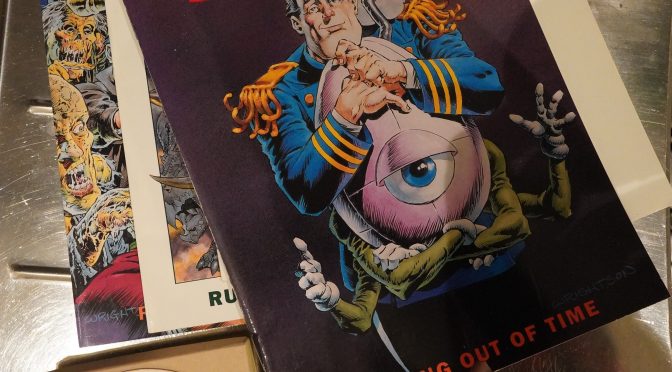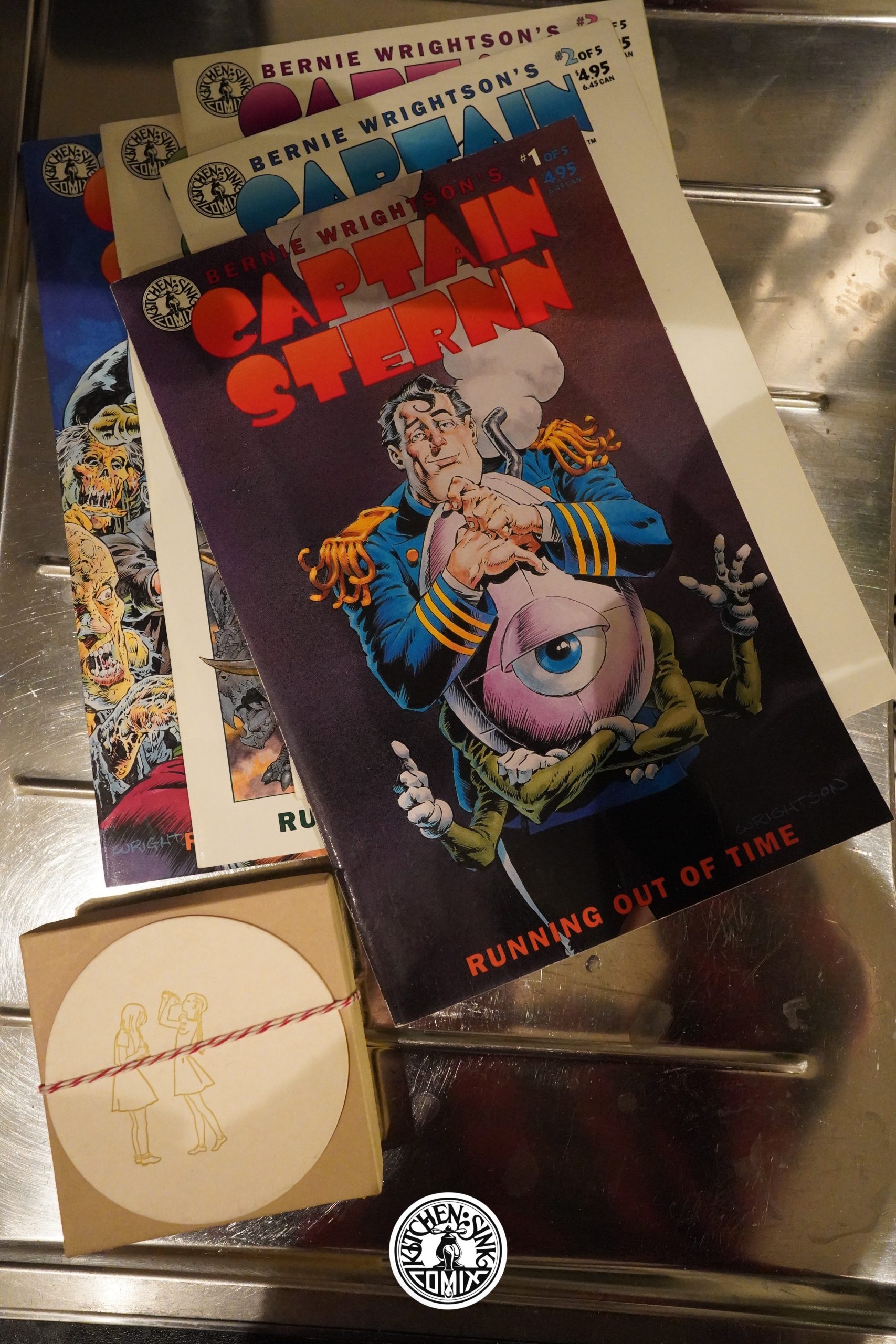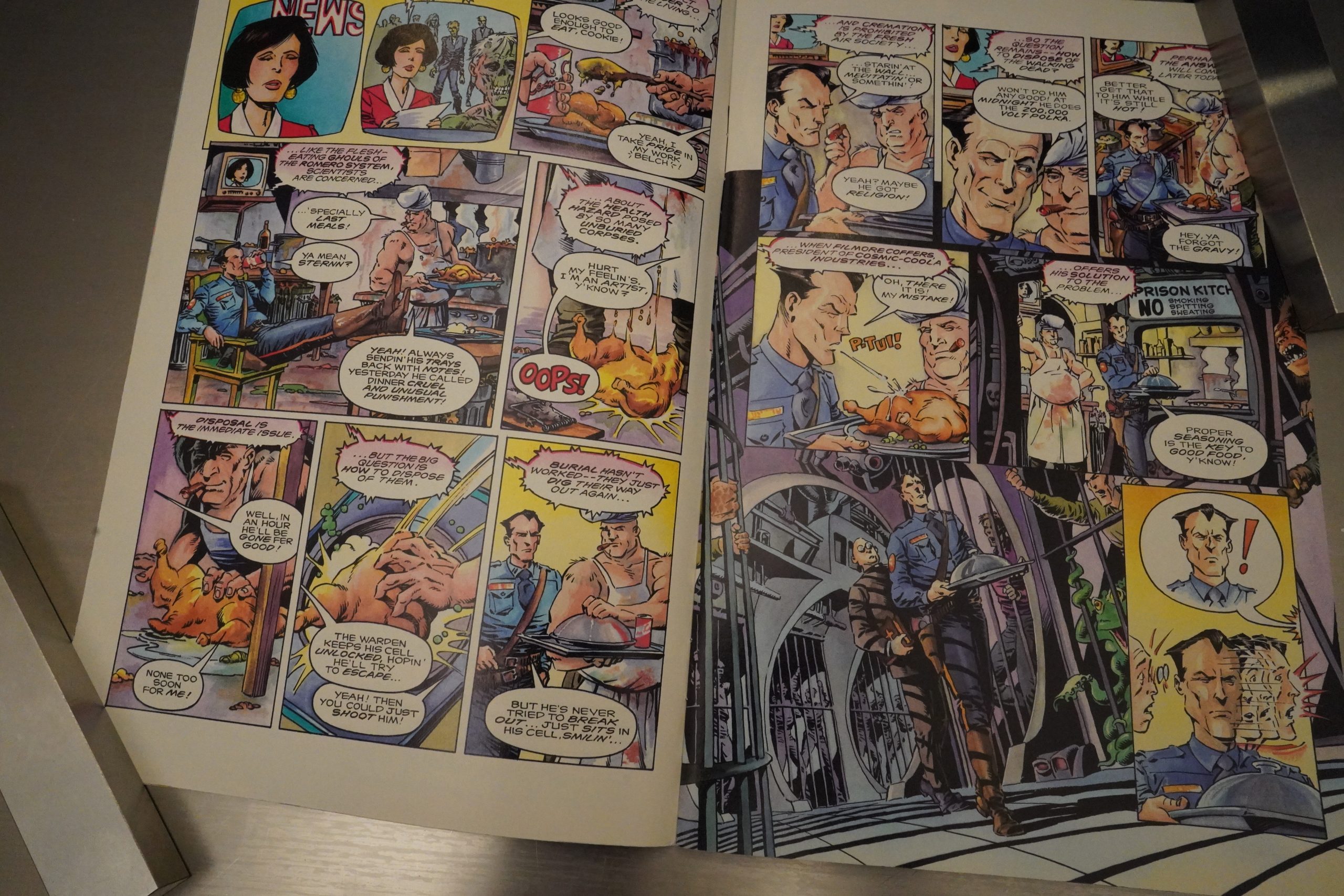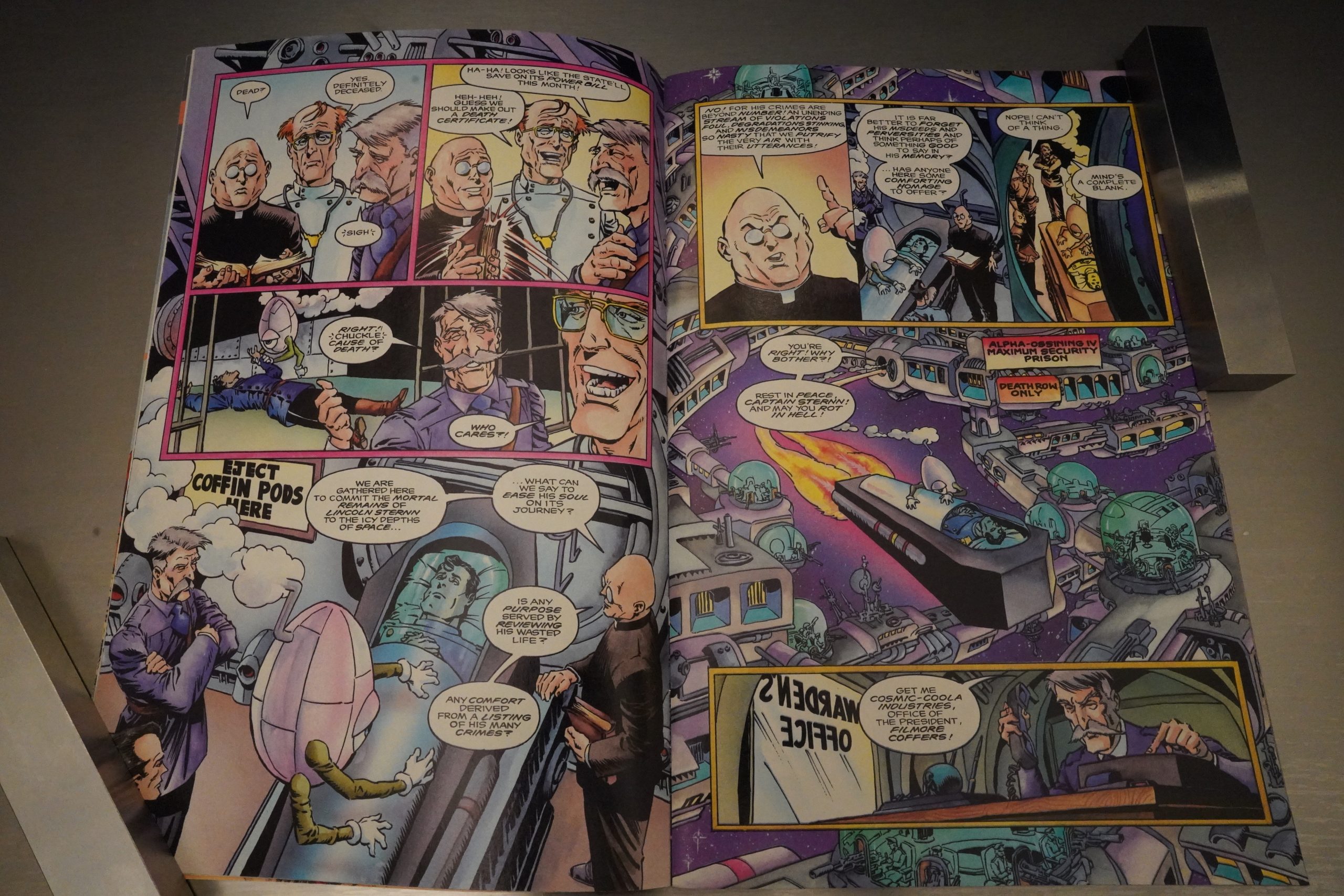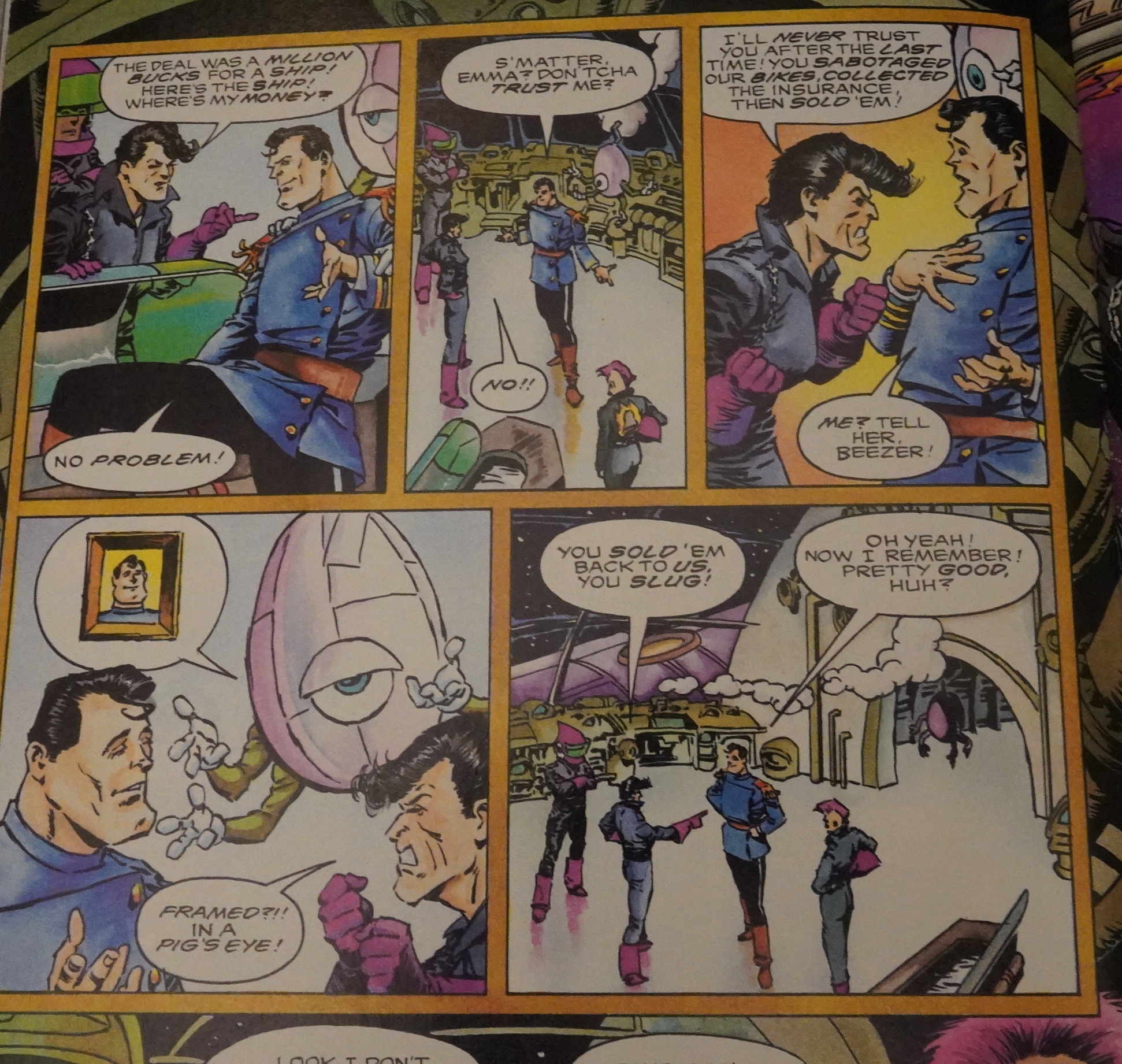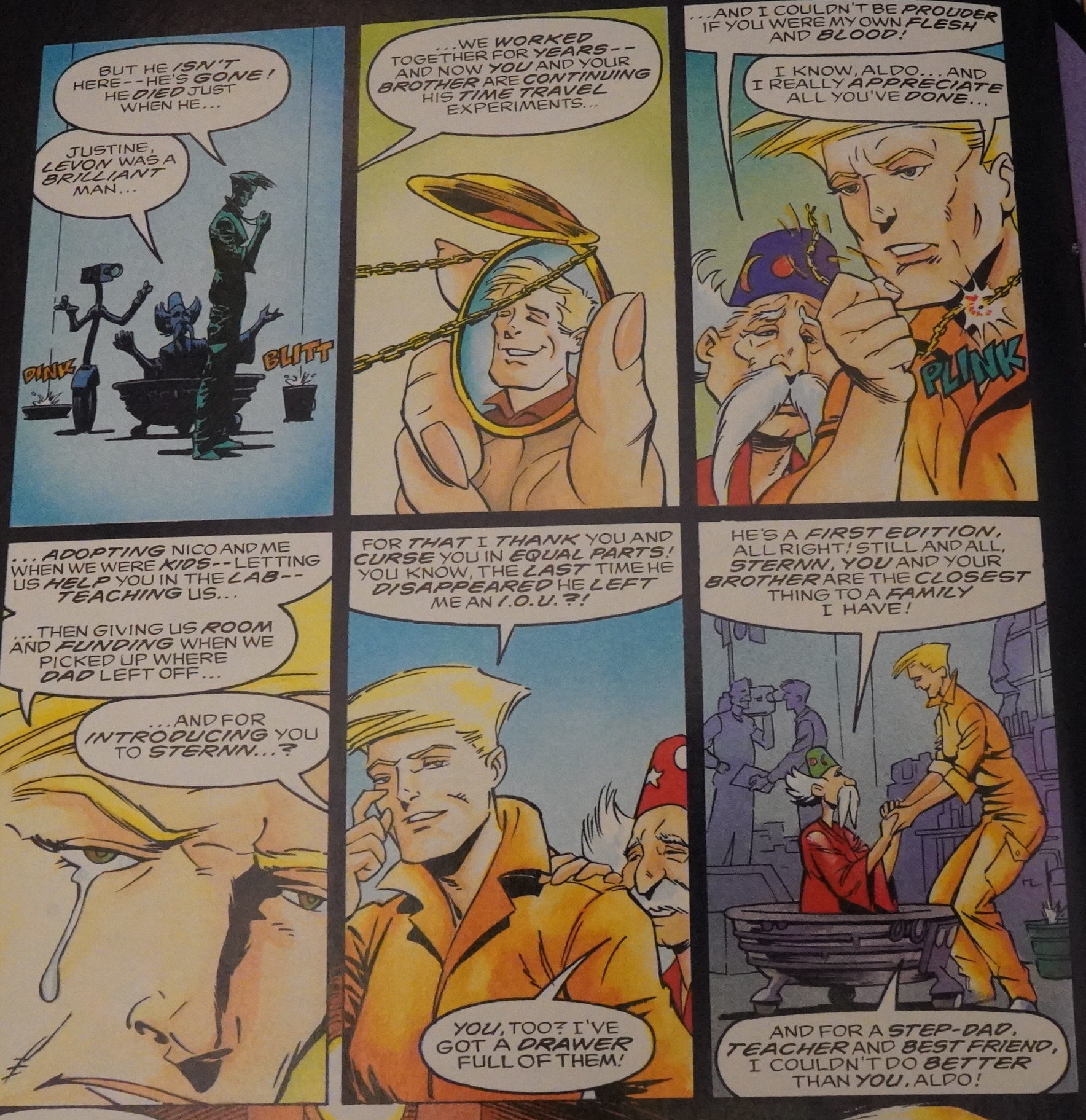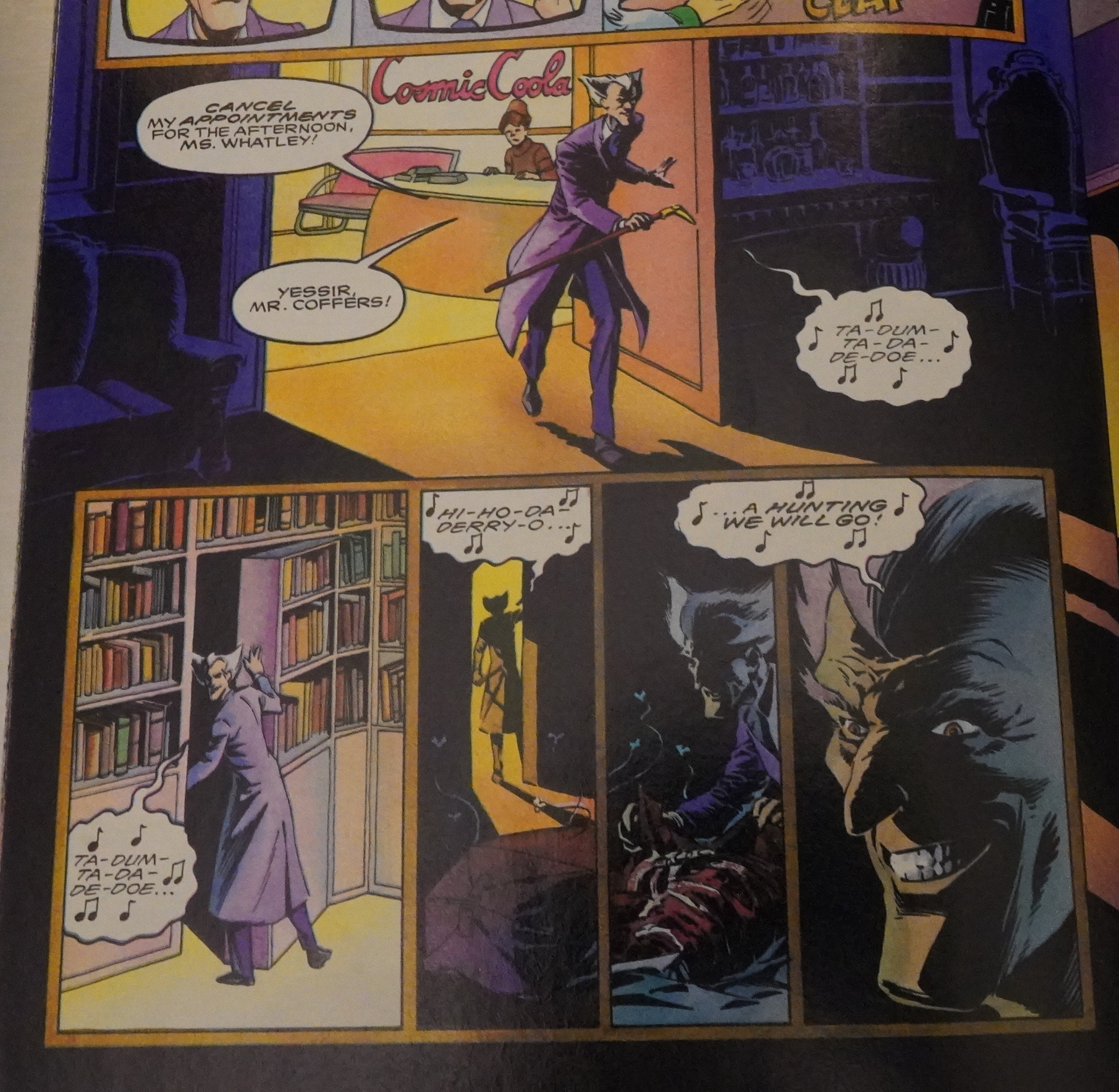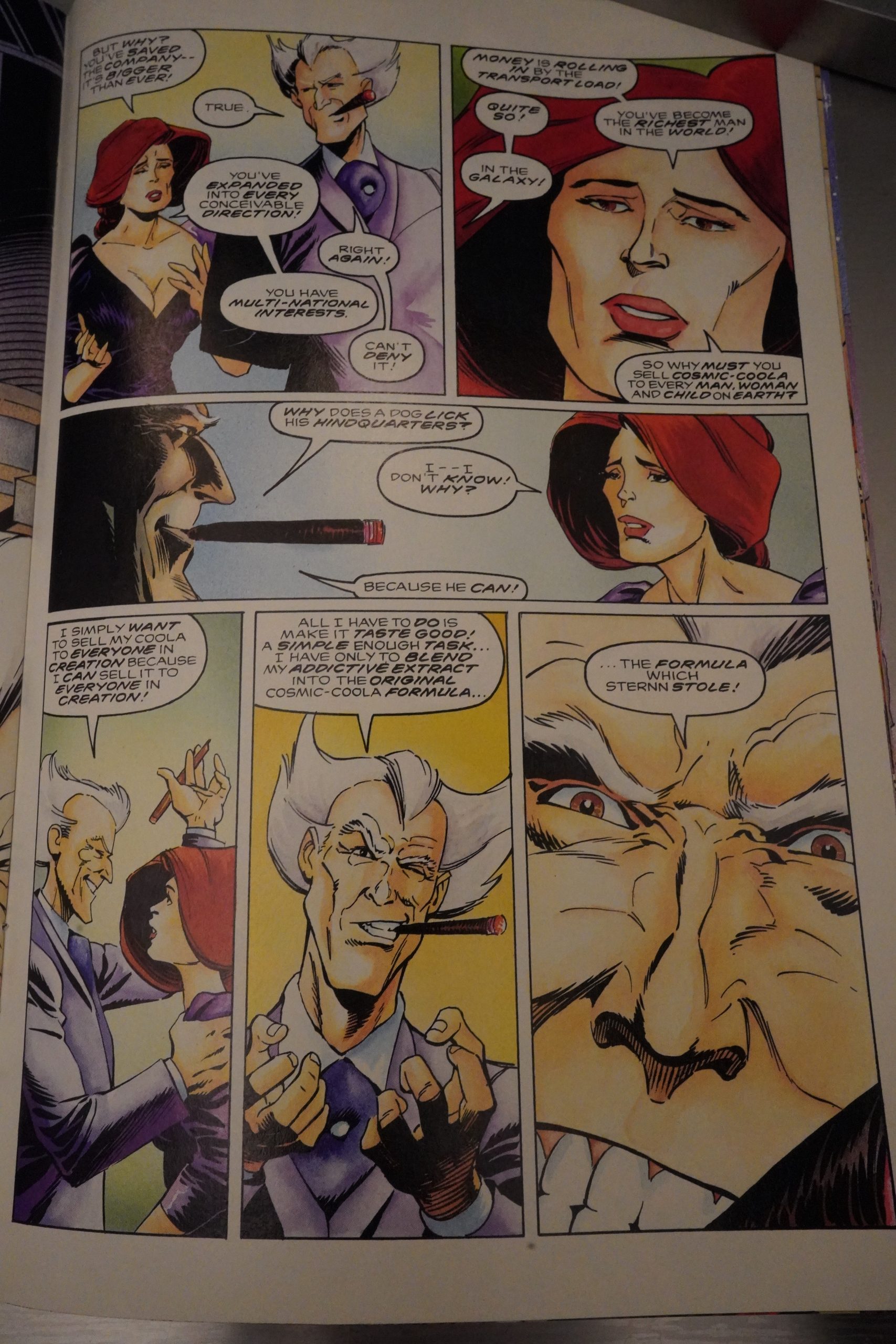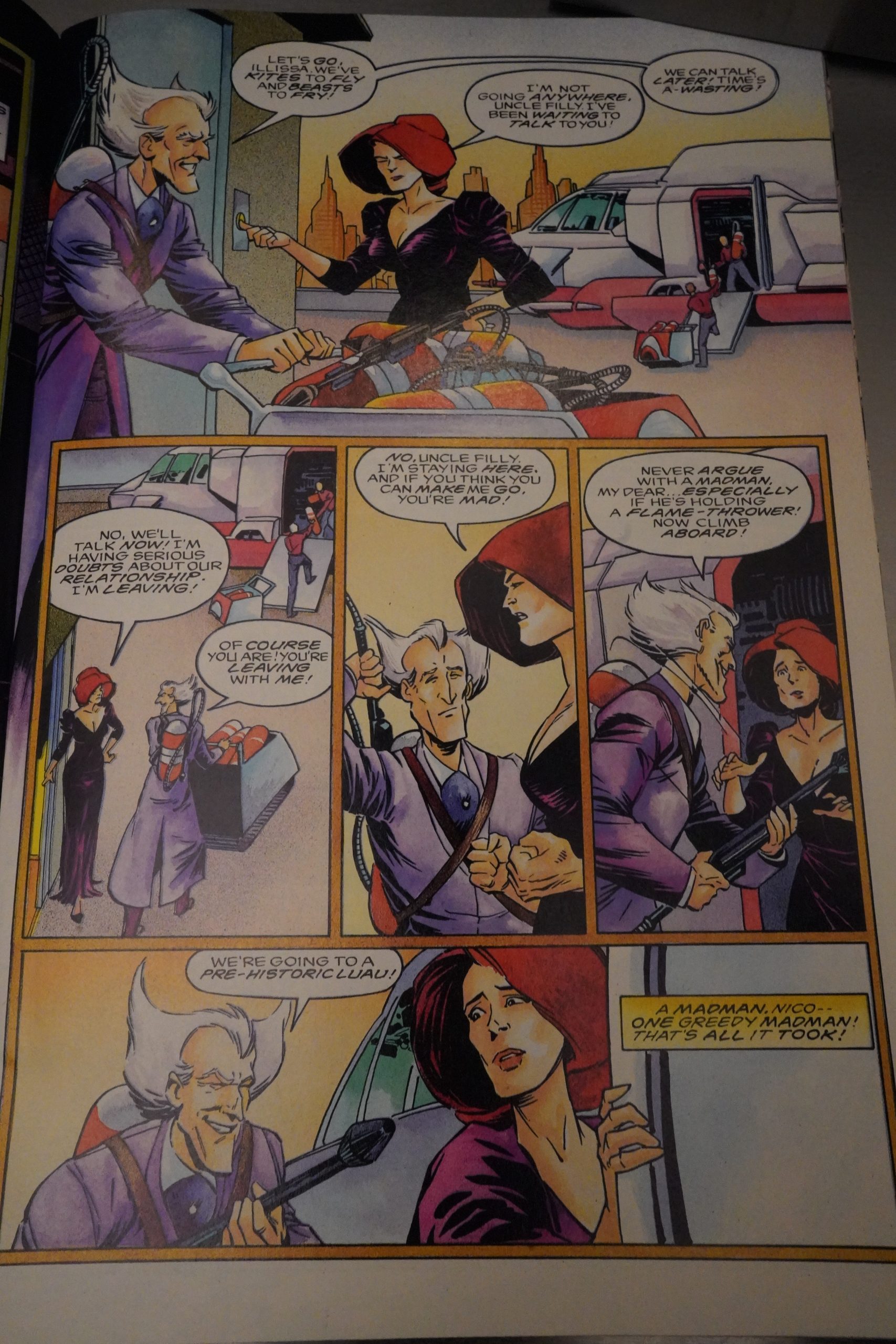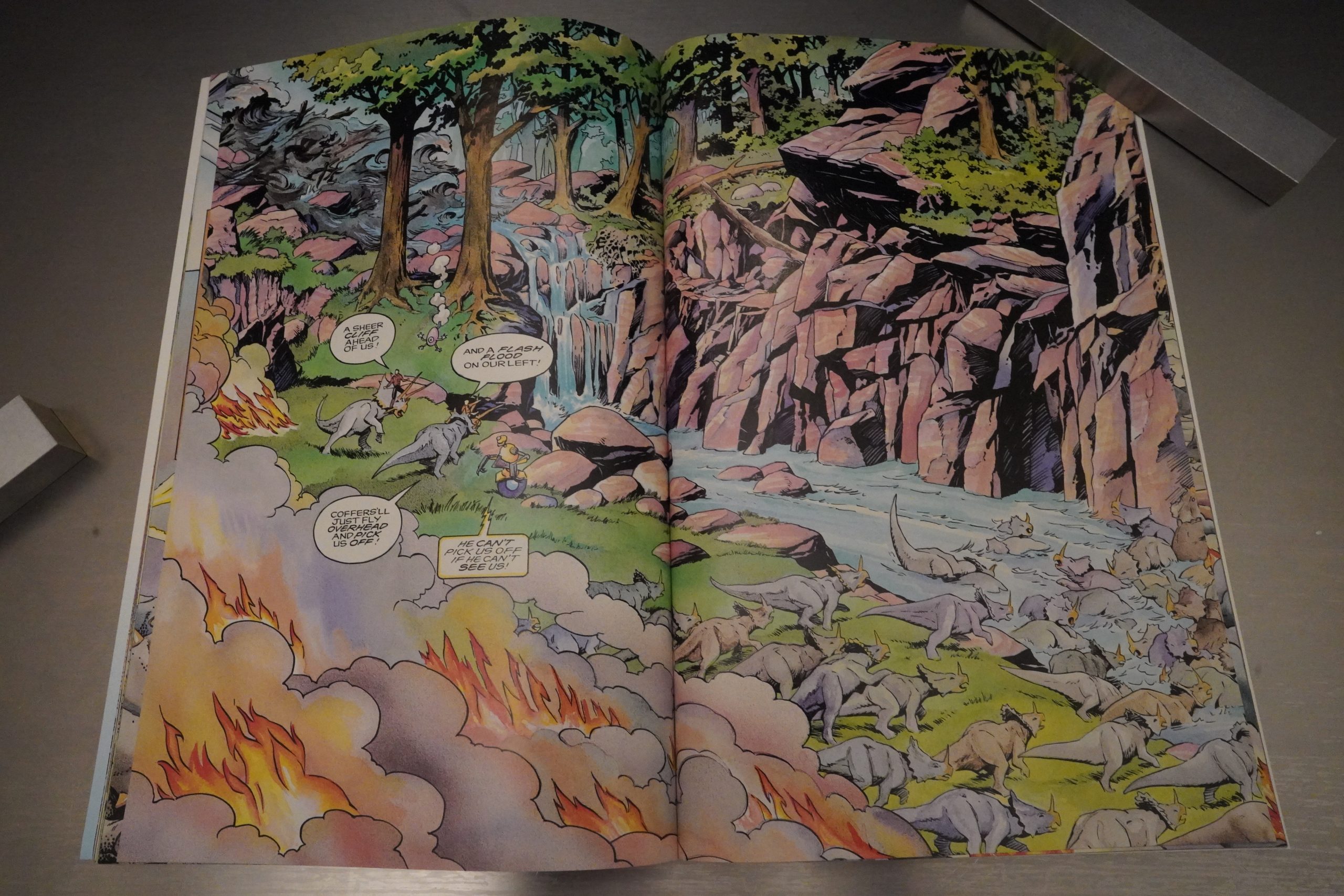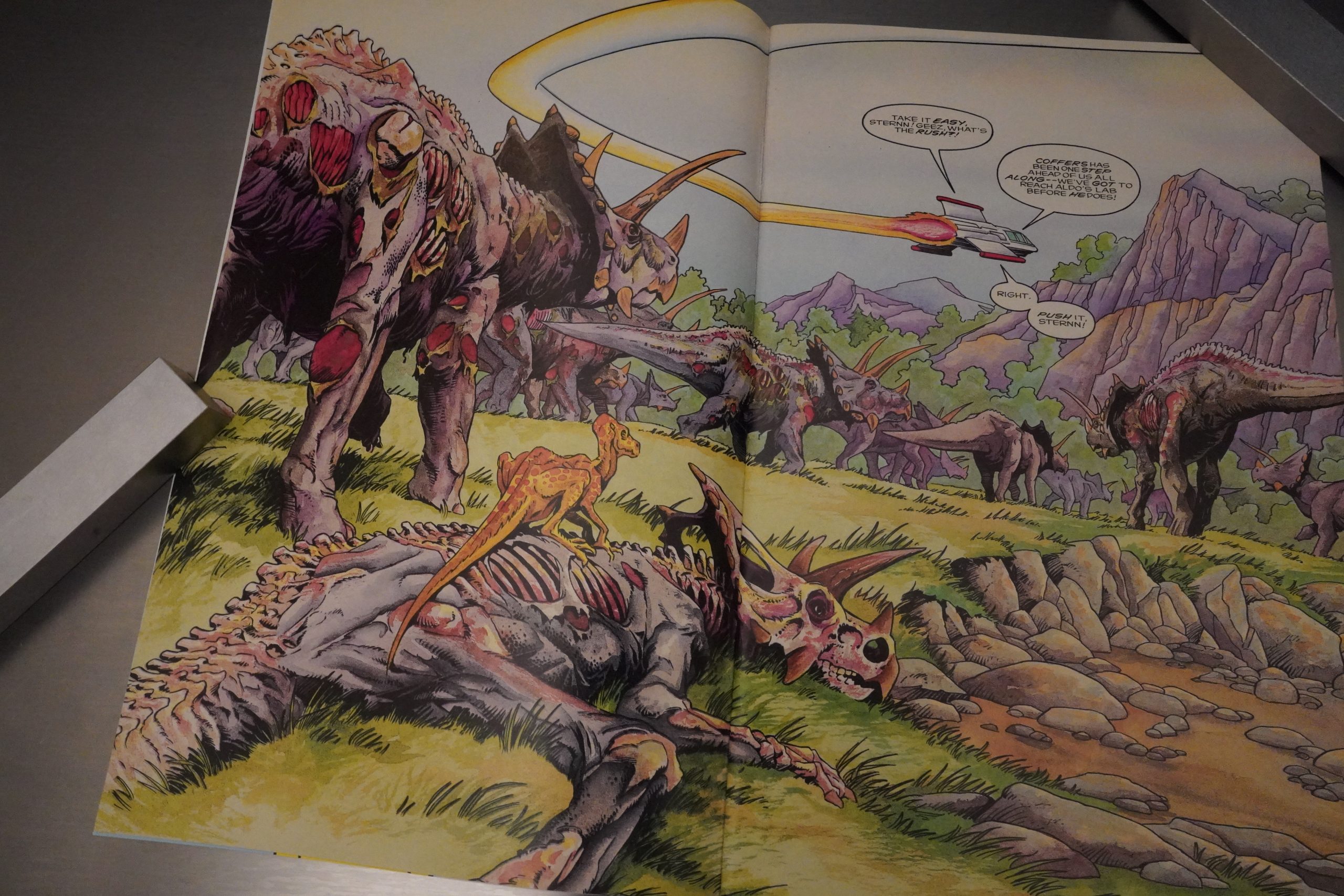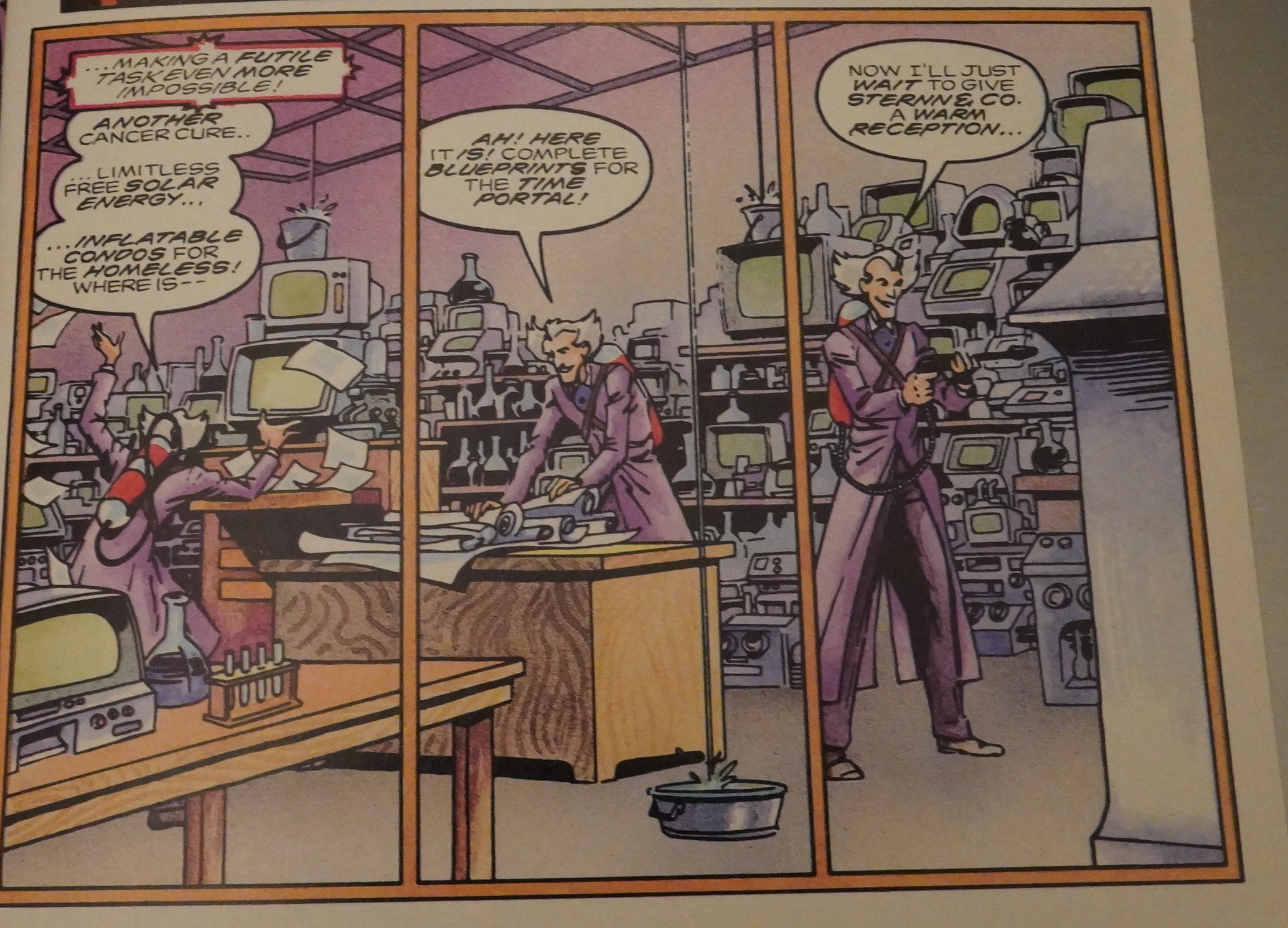Captain Sternn: Running Out of Time (1993) #1-5 by Berni Wrightson, Shepherd Hendrix and others
I remember seeing this series being advertised at the time: A new series from freakin’ Berni Wrightson!? WHERE!? And then I bought it and I remember being bitterly disappointed. But I don’t actually remember anything in specific about the series, so let’s have a look at it.
These books are printed on very shiny, but very thin paper, so I originally thought each issue was 24 pages long (and at $5, so that would scare off many comics fans at the time), but they’re actually 48 pages. In which case, publishing them in the “prestige” (squarebound) format would be more normal, instead of having them be stapled floppies. But I’m guessing that it’s cheaper to print them this way? It still seems like a weird way to “de-class” the book and make it less appealing to potential Wrightson fans.
And… uhm… I would not have guessed that this was Wrightson at all. It looks nothing like his celebrated horror art style. But then again, he’s not inking himself here; somebody called Shepherd Hendrix (who is totally unknown to me) is.
And instead of horror, we get a sci fi comedy thing, which I really didn’t know that Wrightson was partial to.
Uhm… how is that eye’s speech bubble supposed to work? I mean, yes, I get that he says that Sternn was framed, but…
The series starts with a sort of post-Dark Knight cacophonous style with multiple voices overlapping and stuff, but it soon turns to an old-fashioned style where characters out-and-out explain all the backstory to each other (for the benefit of the reader).
So this is starting to look more and more like an Epic comic from 1983, and I have to pause my reading to do some googling.
Oh:
First conceptualized in the late 1970s, Captain Sternn was developed by artist Bernie Wrightson during his time at The Studio. The character’s first published adventure was developed for Tyrannosaurus Press in 1977, and it was eventually published in 1980 in Heavy Metal magazine.
It’s a character that Wrightson did in the late 70s, published in Heavy Metal. And Tundra’s owner, Kevin Eastman, bought Heavy Metal, and that… somehow led to Wrightson reviving this character?
What’s bizarre about this (besides Wrightson not giving the audiences what they presumably want) is that Wrightson is a notoriously slow artist, who commanded top dollar as an illustrator. What could possibly entice him to do a 250 page book (these five issues are 48 pages each)?
Kevin Eastman is interviewed in The Comics Journal #202, page 91:
GROTH: So ubat really happened, then? Finally, to set the
record straight. You bought 51% of Kitchen, and then
Kitchen technically bought Tundra?
KEUIN ERSTMRN
Tundra was a
rucking
nightmare. I
wanted Denis
to haue the full
power to try to
straighten it
out.
EASTMAN: Yeah.
GROTH: For a dollar or Some-
thing like that?
EASTMAN: Yeah. It was, I
can’t exactly remember but,
say bought 51 % (which then
as discussed above was ad-
justed to 49%). Two points
were given to another person
so that Denis could have con-
trol, which was important,
yers convinced me I should
have a Strong position, in case
he did something really
fucked up, and decided to
take acid for a year, I could
step in and fix things. Which
is pretty ludicrous ifyou think
about that concept. Him tak-
ing acid and me coming in to
fix things. He was brought in
to fix them.
GROTH: At least half of that is
ludicrous.
EASTMAN: Lees wait ’til the
polls come in to decidewhich
is the ludicrous one…
GROTH: Right.
EASTMAN: So, thaes basically
how the merger or the acqui-
sition/merger, however you
want to put it, and I don’t
care either way, because ids
the same thing, happened. I committed to x-amount
of fanding, Denis then came in and selected between
his own staff, my staff, his own projects, my projects,
cleaned house, re-located everything in Northampton,
had taken over the commitment to sell and account to
Creators anything that was in the warehouse so that
royalties from previously published books were hon-
ored and paid. Iftherewas anything he didn’twant, the
inventory or that responsibility, at that point it was
offered back to the Creator to purchase at printing cost,
or then, ifthecreator did not take them back, theywere
ulped or recycled. He took over the management,
completion, re-negotiation, and ongoing interest in
projects that he selected for Kitchen Sink from the
Tundra library. End of story.
GROTH: So basically you coughed up two million dollars,
plus a fairly substantial amount of money, no doubt, to
complete some projects, and in return you got 49% of
Kitchen. Essentially.
EASTMAN: Right.
GROTH: Was that a good dealfar you? [laughter]
EASTMAN: Sounded like a good deal at the time. In the
sense that one, I had a publisher with a 25-year
history… was it 25 at that time? No, because they
turned 25 during this time. Well, anywayhe had a very
long history, a well over 20-year history, thatwas well-
respected in the industry. They had a property that was
just going Hollywood, that could be financially re-
warding. He was willing to come in, was dedicated to
the art form, the medium, and he wanted to See some
ofthese projects completed in a fashion that he feltwas
better structured in logical business terms and that
eventually the company, if it was put On the true and
narrow road, could possibly be a profitable company,
which at that point, I hoped to be bought out for a fair
ce and perhaps recoup a tiny percentage of my total
Fundra/KSP investments. Never expecting to recoup
more than a quarter ofwhatever I’d invested in both at
this point, which is about 14 million.
GROTH: Holy ‘bit.
EASTMAN: Holy fucking shit. Yes.
It was respectable, yes.
GROTH: Tundra you $14 million
EASTMAN: Thaes including Tundra .K., and thaes
including Tundra Recording Studios, thaes including
Pro-Media, thaes including the investment in the
Hollywood company, where we had the affliation I
told you about. The investment in the company in
Hollywood alone was a million dollars. It was epic…
I was trying to build an empire, and thought I had the
skill and the moneyto do it. For a while there I at least
had the money and I watched it all go. All the money
I made with the Turtles, and I could tell you almost to
the penny where every bit ofit went, was reinvested in
the medium, at least 70%. Which is nice on the one
hand, because I can account for it, but extremely sad on
the other.
GROTH: O.K. Well, moving right along. Fourteen months
later, Ocean Capital Corporation bought Kitchen Sink so
Iguess what rm… andl don’t even knou ifyou can shed
any light on this, you gave Kitchen 1.5 million dollars the
first year, and committedyourselfto a half-million dollars
the second year, apparently he blown through.
EÆTMAN: What had happened was that with my luck
of all luck, I think that the market started taking a
major downturn at this point. The great stigma of
Tundra continued on through Kitchen Sink in the
sense that projects that creators did for other compa-
nies that sold well, for whatever reasons, sold a lot less
through Kitchen Sink,rrundra. Even things that Denis
took on fairly confident that they would be profitable
were not profitable. The company continued to lose
money at a fairly alarming rate. There was a learning
curve ofmerging the Mo staffs, there was some people
he brought from Wisconsin that ultimately ended up
departing, which caused production gaffes and prob-
lems. There was definitely a lot more holes than he
anticipated, the bleeding continued, the money flew
Out the door. It was hard. I thinkhe tried very valiantly
to stop the bleeding.
QOTH: You refer to a downtum in the market at about the
same time as Kitchen and Tundra merged. And that the
Kitchen company continued to lose money notwith—
standing thefact that be was canceling unprofitable books
and so on. Nonetheless, bow could Kitchen have lost two
million dollars in 18 months even with a bit ofa market
downturn That strikes me as
EASTMAN: If you „ . [lau hs] e , we did it,
Goddamnit. [Groth laughsfNo, ofcourse…
GROTH: But be was supposed to not do it. That was the
whole point of his taking over Tundra.
EASTMAN.’ I think some of the problems Denis faced as
well as he probably traveled down some of the roads I
did with respect to, say, ify•ou do a series ofcolor books
that you’re paying respectable industry standard mar-
quee name creator prices for. Which then brings
expensive printing and expensive pre-press, so what
you lose on something like that you lose big, and ifyou
want to blame it on a downturn Of the market, I guess
there was one. Either way, they just didn’t sell. That if
you looked at it in the sense that books he thought that
would really sell well, didn’t sell at all, or very little, and
so you combined the two and the losseswere epic. You
know? Thaes where I thought he ended up with some
of that left-over Tundra residue or bad apple stigma
that pu would literally lose money just about on every
book sold. perhaps it wasn’t evaluated properly, per-
haps the break-evens weren’t done properly…
GROTH: [laughs] The Tundra curse!
EASTMAN: This is the Tundra curse, continued. [laugh-
ter] So if you look at like, say, five… I’m sure that
Denis could cut you a deal on a bunch of Captain
Sternns that are still in the warehouse. I figured that
each Captain Sternn issue lost thirty thousand dollars
or more per issue, times five, I mean, bam! You’re over
a hundred thousand dollars in fucking losses right
there. Believe me, Tundra cost me $14 million. I was
aware of every penny I “‘as losing. And ifs amazing
how quick it goes. It’s like, it’s like a rock star with a
nasty coke habit. Ids like, “Fuck Where did all my
royalties go?” It’s scary.
Sorry for quoting at length here, but I just found that interesting: Eastman claims to have lost $14M over Tundra’s short life, and taking a bath on $100K on just printing Captain Sternn. So I’m wondering, of course, whether the reason Wrightson did the series in the first place was because Eastman came to him with a huge advance and said “go wild! do anything you want! you rule!” and Wrightson came back with this…
The Comics Journal #82, page 17:
Sternn Returns: Beginning in
the sixth issue, the Epic
Comic Dreadstar will
contain a new, regular co-
feature. Entitled ‘ ‘Inter-
stellar Toybox,” this eight-
page back-up series will be
written and drawn by Berni
Wrightson. The storyline will
continue the exploits Of
Captain Sternn, a
Wrightson-created character
who previously appeared in
both the Heavy Metal movie
and magazine.
Heh — I wasn’t that far off with my Epic Comics comparison: Wrightson had been meant to have a backup series running in Dreadstar in the early 80s, but that petered out after just two issues.
Oops! That’s a lot of googling. Back to the series:
I guess this history also explains why the villain looks quite like one of those characters from… er… House of Mystery? Those DC horror anthologies.
Oh yeah, the plot: It’s about an evil industrialist growing vegetables back in the cretaceous period or something. And a heist, and dinosaurs. It’s all good.
Fortunately he spells out his evil plans at length.
Dinosaurs! Finally! I wonder whether Wrightson pitched this as “you like dinosaurs, right? I’ll do a dinosaur book” and Eastman went “yes! dude!”. Unfortunately, there aren’t really that many dinosaur vistas, and while these pages might have looked super duper cool if rendered in Wrightson’s 70s style, here it’s just kinda… untidy? There’s no weight to these lines, and little drama.
Of course, this is a humour book, so some bits are less heroic on purpose (but there’s a whole bunch of heroically jumping around later).
That woman’s hairdo seemed to get bigger and bigger, and she’s frequently wearing these red carpet gowns to lounge around in. I wondered whether this was a parody of something, but perhaps Wrightson just wanted to draw really big hair…
Well, that’s nice.
Oh, yeah, there’s zombies in this book, too, so we also get zombie dinosaurs.
The final issue is a bit sloppy, production wise. The linework is muddled on some pages, and the colours are slightly our of register on others. But then again, this is in 1994, and the company had run out of Eastman money (Eastman claims that Kitchen Sink lost 2M over 18 months during 1993/94), so I guess they had to hustle.
Finally! A page that looks like actual Berni Wrightson! Almost!
Reading these comics now, I understand my disappointment from the 90s. But these aren’t all that bad, really? Without all the baggage… I mean, if I happened onto this book, and was told that it was a lost book from 1983 by some unknown creator — I would probably have thought that it was all OK. It’s got some good gags, it’s got a pleasantly convoluted storyline, and the artwork is lively, if unremarkable.
It’s fine, really.
The Comics Journal #158, page 18:
Another thing that Eastman had not an-
ticipated, and that which in the end became his
greatest frustration, concerned his dealings with
creators. Eastman believes Tundra’s generosi-
especially with advances, and lenient at-
titudes about deadlines contributed to numerous
situations where work was either turned in late
Or not at all.
For Eastman, the “worst part of the job”
became calling up creators he respected and
muscling them over projects. He agonized over
how to approach such matters and “lost many
nights of sleep as I mapped out what I was go-
irig to have to say to these people.”
The company’s internal documents list
several such cases of work being either delivered
late or not at all, as well as other assorted pro-
blems. Eastman confirmed that Dave McKean
was unable to give the company a “firm
schedule” for his work on the Cages series.
McKean acknowledged that some delays were
unavoidable. “All I wanted to do was get a book
out that I was completely happy with. Tundra
did this for me.”
Eddie Campbell was advanced money for a
project. referred to as Hellfire Club, that never
materialized. Campbell conceded by phone
from Australia that he “pulled the plug on the
project” and transferred his advance money to
a new project, Georgette, now being released
under the title Graffiti Kitchen.
Documents dated December 19, 1991 show
that Freedom Project by Michael Davis and
David Quinn had also fallen “way behind,” but
Eastman holds no grudge. Neither Davis nor
Quinn could be reached for comment.
Deadlines on Mark Beachum’s I_nmina were
• •blown almost immediately,” according to
Eastman. Despite promises and assurances,
Beachum’s work failed to appear on schedule,
“which in turn held up seven other people.”
Beachum was not available for comment.
• •It was just insane,” Eastman recalls.
met with him several times to plead with him
— listen. I’m not trying to be an asshole or a
tyrant — just tell me when you can turn the work
in and we’ll work with you on it.”
“I would tell these people (creators), ‘just
be honest with me — if you can’t turn it in for
a year, we’ll work with that — I’ve paid you
some money, you’ve done a fraction of what
. there’s no need for
you’ve been paid to do .
this: And then when they’d lie, it was a slap in
my face ’cause I was trying so hard.”
“These types of dealings were extremely
difficult for me
. nobody wants to be an
asshole. and that’s probably what got me into
so much trouble, my inclination to be nice .
Definitely bad from a business point-of-view,”
said Eastman.
Other projects were doomed, damaged, or
derailed by a variety of unseen obstacles.
Bernie Wrightson developed some medical
problems and was unable to proceed “at the
same pace and capacity” as originally intend-
ed for Captain Sternn, according to Eastman.
As far as I can tell, this series has never been reprinted, which is surprising.
They seem to be selling for respectable amounts on ebay, for instance.
Since it’s never been reprinted, there’s apparently no reviews out there, either?
Captain Sternn, Running Out of Time v1 #5, 1993 – As this issue marks the end of the limited series, the artwork seems to run out of steam at the same time. Bernie Wrightson’s layouts are paced more erratically and even his four two-page spreads lack the excitement of previous issues. Pages 29-30 are especially disappointing in their lack of effort.
This is the one hundred and fifty-seventh post in the Entire Kitchen Sink blog series.
